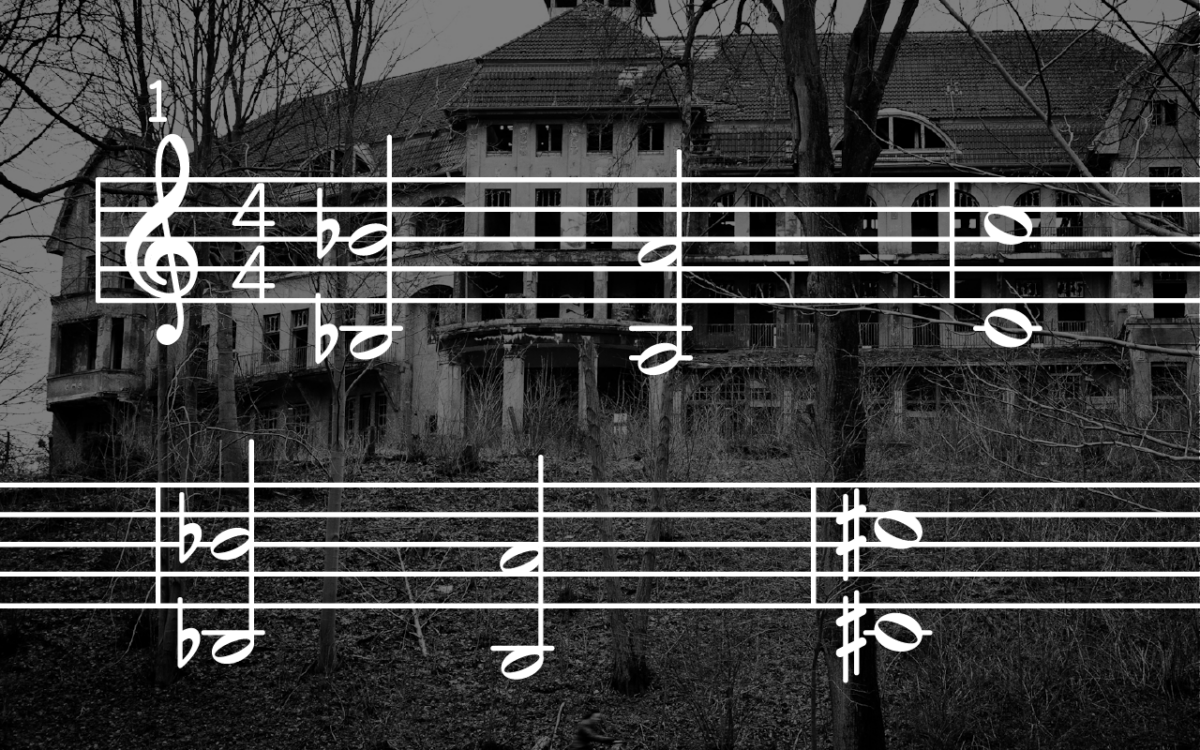Does the Lavender Town theme from Pokémon give you the shivers?
Do you remember running from the monster piano and flying books to the creepy music in the haunted house from Super Mario 64? With Halloween right around the corner, there’s no better time to dive into a piece of “spooky” video game music and the compositional techniques that elevate the fear factor of the game. More specifically, let’s take a look at the soundtrack of a more recent video game—Undertale.
“Your Best Nightmare” (Undertale)
There’s a heated debate in the Undertale community on whether the scariness of Flowey compares to that of Earthbound’s Giygas, considering the Earthbound franchise is said to have influenced game developer and composer Toby Fox when he was creating Undertale. Some view Undertale as nothing more than a big homage to Earthbound, but wherever you might stand on the matter, it’s undeniable that Toby Fox maintains a unique voice as a composer and storyteller—Photoshop Flowey’s battle theme proves this, standing distinct from Giygas’ theme or other spooky video game pieces in general that come to mind.
1. Tonal ambiguity
Let’s start by taking a look at the opening melodic idea (0:00): This melody demonstrates a popular quality of “spooky” music—tonal ambiguity (or outright atonality). B♭, A, C, and C♯ don’t belong in any major or natural minor key, which immediately throws the listener into a land of uncertainty and tension (you could maybe argue that the piece is in B♭ harmonic minor if the C♯ is respelled as a D♭, but this assumption will quickly be abandoned in upcoming sections of the piece). The sinister mechanical sound of the synth really heightens the unsettling tone of this melody.
This melody demonstrates a popular quality of “spooky” music—tonal ambiguity (or outright atonality). B♭, A, C, and C♯ don’t belong in any major or natural minor key, which immediately throws the listener into a land of uncertainty and tension (you could maybe argue that the piece is in B♭ harmonic minor if the C♯ is respelled as a D♭, but this assumption will quickly be abandoned in upcoming sections of the piece). The sinister mechanical sound of the synth really heightens the unsettling tone of this melody.
2. Unpredictable melodic contours
After a suspenseful silence and spine-chilling laugh, the piece explodes into a beatcore-driven section with the melody above paired against a bassline that looks something like this (0:22):

 And here we were thinking the opening melody was ambiguous! This bassline is truly void of tonality as we know it, almost twelve-tone in its arrangement of pitches. What further makes this bassline so unnerving is its contour—notice how the trajectory of the notes twists and turns in a very erratic manner. When writing your own scary music, try not only selecting unpredictable pitches, but pairing them with unpredictable melodic contours.
And here we were thinking the opening melody was ambiguous! This bassline is truly void of tonality as we know it, almost twelve-tone in its arrangement of pitches. What further makes this bassline so unnerving is its contour—notice how the trajectory of the notes twists and turns in a very erratic manner. When writing your own scary music, try not only selecting unpredictable pitches, but pairing them with unpredictable melodic contours.
3. Emotional contrast
Let’s take a look at one more section of the piece (0:59): Just as we’re starting to get used to the mayhem, Toby Fox takes a sharp turn and introduces this cheerful, songlike tune. The melody sounds like it’s straight out of a beginner’s piano book, and it’s accompanied by a textbook arpeggiated chord progression where the first phrase ends on a half cadence and the second phrase ends with a perfect authentic cadence.
Just as we’re starting to get used to the mayhem, Toby Fox takes a sharp turn and introduces this cheerful, songlike tune. The melody sounds like it’s straight out of a beginner’s piano book, and it’s accompanied by a textbook arpeggiated chord progression where the first phrase ends on a half cadence and the second phrase ends with a perfect authentic cadence. The melody is actually a direct quote of the cheery “Your Best Friend” theme, which the player hears when they first meet Flowey. The difference is that this time the player knows how evil the flower really is, and this new context gives the jovial tune a mocking, twisted quality.
The melody is actually a direct quote of the cheery “Your Best Friend” theme, which the player hears when they first meet Flowey. The difference is that this time the player knows how evil the flower really is, and this new context gives the jovial tune a mocking, twisted quality.
When composing your own game music, consider emphasizing contrast—we all know how the scariest scene of a horror movie isn’t always the part accompanied by piercing strings, but the part where a child starts singing an “innocent” nursery rhyme.
Hopefully you can incorporate some of the ideas we talked about (tonal ambiguity, unpredictable melodic contours, and emphasizing contrast) in writing your own scary video game music.
Interested in exploring more video game music analyses? Check out our harmonic analysis of The Legend of Zelda‘s overworld theme and our exploration of the bassline in Super Mario Odyssey‘s “Jump Up, Super Star!”
Explore royalty-free melodies, chord progressions, and grooves by key, BPM, genre, and more:
October 27, 2017

.svg)
.svg)




